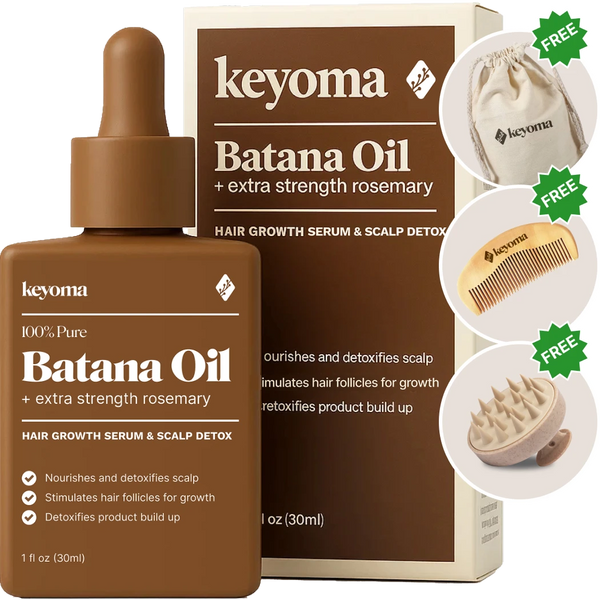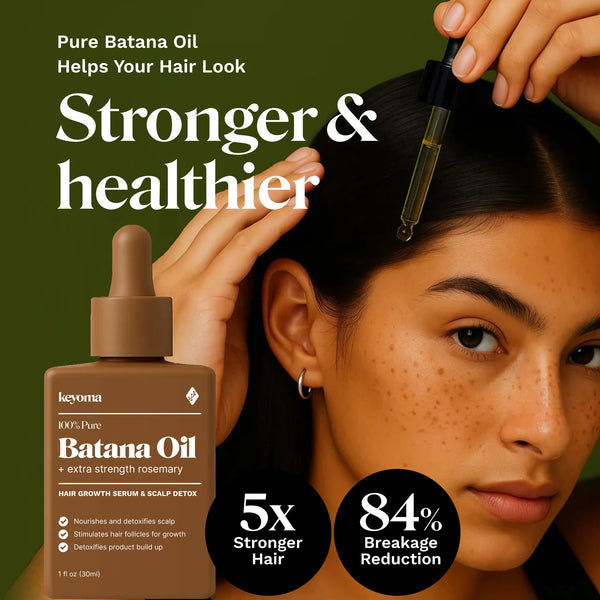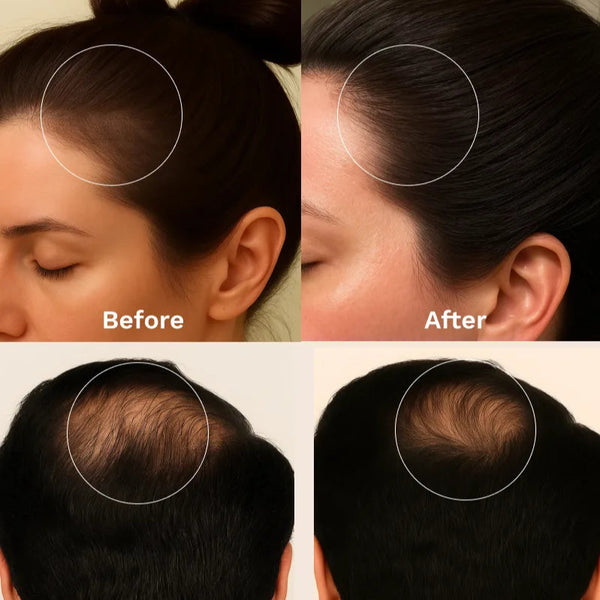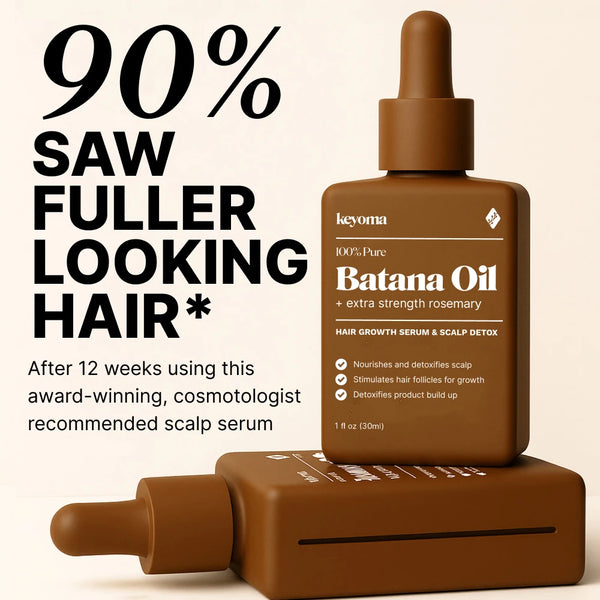In this article
Some daily shedding is normal. Most people lose up to 100 hairs a day. Still, some people notice additional hair loss.
Male and female pattern baldness are the main reasons for hair loss, but other conditions and lifestyle factors can also play a role. A doctor will assess possible causes before suggesting the right treatment.
Below you’ll find 17 reasons why your hair falls out, the treatments that exist, and simple at-home tips to slow further shedding.
Key Takeaways
-
Normal shedding reaches about 100 hairs daily, more than that may signal underlying causes.
-
Androgenetic alopecia is common, while aging, hormones, stress, illness, and medications also trigger shedding.
-
Treatments include minoxidil, finasteride, spironolactone, low-level lasers, platelet-rich plasma, transplants, and results vary.
-
Gentle care, natural oil (batana, rosemary, etc.), addressing deficiencies, looser styles, and treating conditions can reduce shedding or regrow hair.
1. Genetics and Heredity
Androgenetic alopecia, or hereditary loss, happens due to genes or hormone shifts that affect androgens like testosterone.
Anyone can develop it, though it’s more common in men and often called male pattern baldness. In men, hair thins on the crown and temples, creating an “M”-shaped hairline.
In women, hair tends to thin across the scalp without a receding hairline.
2. Aging
With age, hair naturally thins and growth slows. Over time, aging can cause hair follicles to stop producing hair.
Going gray also changes hair structure as pigment fades. The outcome is graying hair that can become fine and white.
Treatments like minoxidil may support regrowth if you start early.
3. Androgenetic Alopecia (Pattern Hair Loss)
Androgenetic alopecia is the medical name for male or female pattern baldness. It’s also called hereditary alopecia. It is a common cause of hair loss.
This condition is genetic. Men often lose hair from the temples and crown, while women usually notice diffuse thinning across the scalp.
It becomes more likely with age, though it can start any time after puberty. Many women develop androgenetic alopecia after menopause, likely influenced by hormones.
You can treat androgenetic alopecia with minoxidil (Rogaine, Loniten), a hair growth medication. It generally takes about 6 to 12 months to see noticeable improvement.
Other possible options include:
-
Finasteride (Propecia), a drug used to treat male pattern baldness
-
Spironolactone (Aldactone), which may help reduce female pattern thinning
-
Laser therapy, applying low-level lasers to the scalp to stimulate growth
-
Platelet-rich plasma, where a doctor injects plasma from your blood into the scalp
-
Hair transplant, moving healthy follicles from one scalp area to another
-
Certain nutritional supplements
4. Pregnancy
Some people notice heavy hair loss shortly after delivery. A drop in estrogen is the reason. This shedding is temporary and usually settles within a year or sooner.
You can try to boost the look of fullness by:
-
Using products made for fine hair
-
Picking a volumizing shampoo and conditioner
-
Skipping heavy conditioners or 2-in-1 formulas that can weigh fine hair down
-
Keeping conditioner on your ends, not your scalp, to avoid flatness
5. Telogen Effluvium
Healthy follicles cycle through four phases of growth.
During anagen, the follicle produces hair. In catagen, growth slows. Shedding starts in telogen and increases in exogen.
Telogen effluvium happens when hair stays in the telogen stage. More strands than usual fall out, sometimes by the handful.
Triggers for telogen effluvium can include:
-
Childbirth
-
Surgery
-
Severe stress
-
Rapid weight loss
-
Thyroid conditions
-
Certain medications
Telogen effluvium is typically short-term and improves over time, but it’s wise to see a doctor to find the cause. Treating the underlying issue can reduce shedding.
If a medication seems to be the reason, a doctor may lower the dose or switch to another drug.
6. Anagen Effluvium
Anagen effluvium causes rapid, heavy loss during the anagen (growth) stage. It can affect hair on the scalp and other areas, including brows and lashes.
Possible causes include:
-
Chemotherapy
-
Radiation therapy
-
Fungal infections
-
Autoimmune disease
Treatment depends on the cause, but a topical minoxidil (Rogaine) solution may be used.
If chemotherapy is the cause, cooling the scalp during treatment may help. Hair often returns within 3 to 6 months after chemotherapy ends.
6. Alopecia Areata
Alopecia areata is an autoimmune disorder that causes sudden shedding. The immune system attacks hair follicles and other healthy tissues.
Hair on the scalp, eyebrows, and eyelashes can fall out in small patches.
If you notice this pattern, contact a doctor. They may suggest corticosteroid injections to the scalp or prescribe other medicines to encourage regrowth.
7. Traction alopecia
Traction alopecia is hair loss from tight hairstyles that pull strands until they break. Styles linked to this include:
-
Tight buns or ponytails
-
Braids
-
Cornrows
-
Extensions
If it continues, you may see thinning and patchy loss. Looser styles usually prevent more damage.
8. Cancer Treatment
Chemotherapy can harm follicles, leading to loss on your head and body. You might shed from the scalp, pubic area, eyebrows, eyelashes, and more. The scalp can feel sore or itchy too.
Radiation therapy can damage follicles as well. Hair often grows back a few months after treatment, depending on the level of damage.
A cooling cap may help prevent loss. Ways to handle hair loss from cancer treatment include:
-
Avoid styles that pull your hair
-
Comb your hair gently
-
Cover your head with scarves or turbans
-
Cut your hair shorter
-
Wear a wig
9. Stress
Stress-related shedding usually stops within 6 months of the stressful event, and your hair often returns to its usual thickness.
Ways to manage stress include:
-
Eat a balanced diet
-
Exercise regularly
-
Get plenty enough sleep
-
Speak with a mental health specialist
-
Try deep breathing exercises and meditation
10. Medications
Some medicines have side effects that cause shedding.
Examples include certain types of:
-
Acne drugs
-
Antifungals
-
Antidepressants
-
Beta-blockers
-
Cholesterol-lowering drugs
-
Hormone-containing drugs
-
Thyroid medications
If you suspect a drug is causing shedding, talk with a doctor. They might reduce the dose or switch your prescription.
11. Birth Control Pills
Some people shed while taking birth control pills. Others notice loss several weeks or months after stopping them.
If you use birth control pills, choosing one with a low androgen index may lower the risk of shedding.
Lower-androgen options include:
-
Desogen
-
Ortho-Cept
-
Ortho-Cyclen
Ovral and Loestrin have a higher androgen index.
Other hormone-based methods, such as implants and patches, can also lead to hair loss.
The American Hair Loss Association suggests people at higher genetic risk consider nonhormonal birth control.
12. Nutritional Deficiencies
Lack of certain nutrients can cause shedding. Strict diets that skimp on protein or key vitamins, such as iron, can sometimes trigger excessive shedding.
Ask a doctor about blood tests to check for deficiencies that could be behind your loss.
Diet changes and supplements may be recommended to correct a deficiency.
13. Ringworm
Ringworm is a fungal infection that can cause hair loss. Tinea capitis is the term for ringworm on the scalp and can lead to temporary bald patches.
Symptoms may include:
-
scaly, discolored ring-shaped patches on the scalp or skin
-
patches of loss that start small and grow over time
-
oozing blisters
-
itchiness
-
brittle strands that break easily
If ringworm doesn’t clear on its own, a doctor may prescribe an antifungal such as griseofulvin.
13. Trichotillomania
Trichotillomania is an obsessive-compulsive disorder (OCD) where you pull out your own hair. This can injure hair follicles and the skin.
Trichotillomania often improves without treatment. Cognitive behavioral therapy (CBT) can help manage stress and reduce pulling.
15. Hair Damage
Wearing tight styles, coloring, perming, chemical relaxing, or frequent heat styling can lead to traction alopecia.
Traction alopecia can be permanent. Ways to prevent hair damage include:
-
Avoid tight hairstyles, weaves, or hair extensions
-
Brush your hair when it is wet
-
Do not get your hair colored, permed, or relaxed too close together (wait at least two weeks between)
-
Follow up shampooing with conditioner
-
Wait 8-10 weeks between coloring touch-ups
-
Wrap your hair in a towel or air dry it
You might also lose hair where clothing rubs the skin, known as frictional alopecia. It’s more common on the legs.
16. Hormonal Imbalance
In polycystic ovary syndrome (PCOS), the ovaries produce higher androgen levels, which can thin hair at the temples and the front of the scalp.
Hormonal birth control pills may lower androgens. Stopping them can cause temporary shifts that thin hair.
Menopause can also lead to thinning as your body makes less estrogen.
17. Thyroid Disease
Thyroid disease creates hormone imbalances that affect your whole body. You may notice thinning hair, finer strands, and sparse eyebrows.
This loss is often temporary. Treating thyroid dysfunction may support regrowth, though some thyroid medicines can also cause loss.
18. Poison
Substances that can poison and lead to hair loss include:
-
Arsenic
-
Boric acid
-
Lithium
-
Mercury
-
Selenium
-
Thallium
-
Vitamin A
-
Warfarin (an ingredient in rat poison)
Hair often grows back once exposure stops.
How to Treat Hair That Is Falling Out
According to the NHS, most hair loss doesn’t need treatment because much of it is temporary or a natural part of aging.
Still, patience helps. New growth can take months, and it often takes longer before it looks close to “normal” again. I noticed monthly photos made those small changes easier to spot.
Even so, you can try a few approaches to manage loss:
-
Support your overall health if lifestyle is a factor. Aim for a balanced diet with enough protein, plus essential vitamins and minerals.
-
Handle your hair and scalp gently, avoiding frequent heat styling and dyeing. Choose mild, sulfate-free products.
-
If you want targeted treatment, remember that no remedy is 100% effective. Options include minoxidil (aka Rogaine), which may counteract loss and slow pattern baldness. You’ll need daily use for results.
-
For male pattern loss, finasteride (Propecia) can reduce DHT to support more growth and less shedding.
-
For some types of loss, steroid injections or creams and ultraviolet (UV) light may have benefits.
If you’re losing clumps, see a doctor. They can advise you on effective FDA-approved options.
Practical Ways to Prevent Hair From Falling Out
Some hair loss is genetic or illness-related, so there’s no guaranteed way to prevent it. Still, it helps to review your habits and tweak what you can.
Those tweaks might include easing stress with regular exercise or calming practices like yoga or meditation. You can also aim for enough sleep and more nutrients by eating extra fruits and vegetables. For me, a short outdoor walk calmed stress better than any app.
Treat your hair gently, too. Avoid harsh alcohols and limit drying heat tools.
Identify Hair Loss Causes, Start Gentle Care With Keyoma
Keep your routine gentle while treatments do their job. For a natural start with fewer side effects, or a supportive add-on to your current plan, use Keyoma’s Batana Oil with Rosemary as a daily scalp oil to add simple, nourishing moisture and everyday comfort.
Featured Product
100% Pure Batana Oil + Rosemary
↓Best Batana Oil to Buy↓
1 Month
Subscribe & Save
- 30-day supply delivered monthly $35
- 30% off for life $6
- Free haircare essentials kit $33
- Free custom wooden comb $10
- Free scalp massager $15
- Free eco-friendly travel bag $8
- 30-Day Money Back Guarantee
- Free Shipping
- Online portal for easy cancel, skip, or pause.
1 Month One Time Purchase
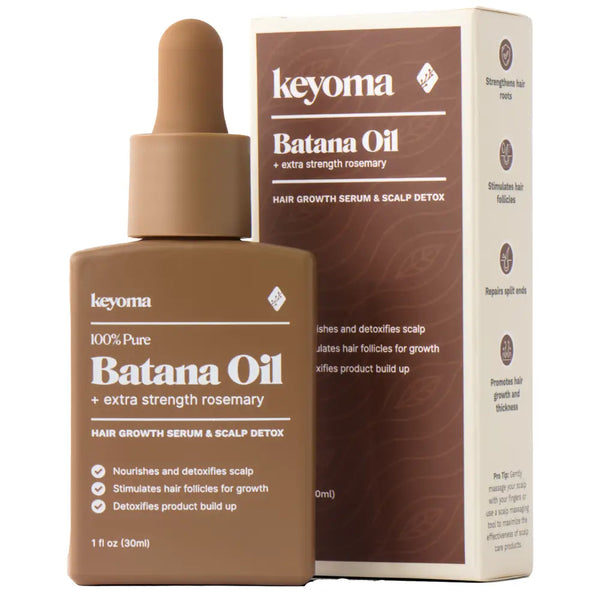
- 30-day supply $50
- 30% off for life $6
- Free haircare essentials kit $33
- Free custom wooden comb $10
- Free scalp massager $15
- Free eco-friendly travel bag $8



